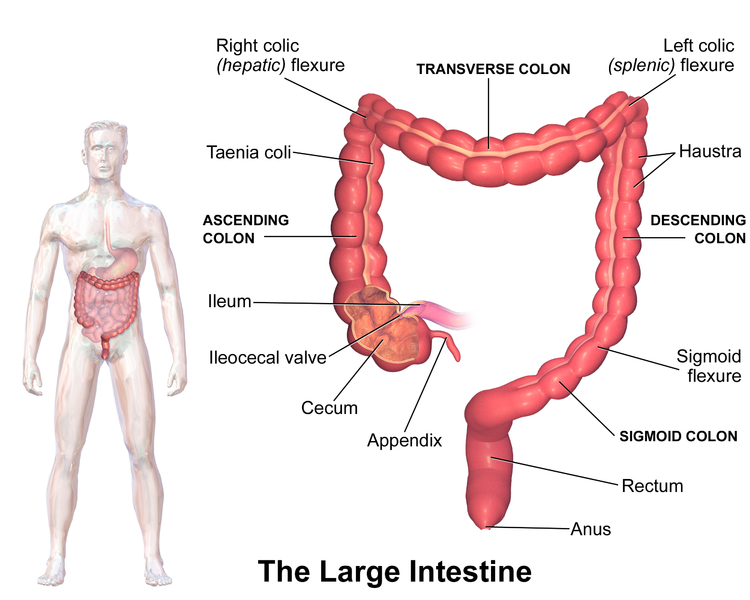
Anatomy
Abdomen
Which of the following is the most common position of the vermiform appendix:
Answer:
The most common position is retrocaecal, followed by pelvic.Large Intestine: Appendix
Anatomy / Abdomen / Gastrointestinal Tract
Last Updated: 11th April 2019

Large Intestine. (Image by Blausen.com staff. “Blausen gallery 2014”. Wikiversity Journal of Medicine. DOI:10.15347/wjm/2014.010. ISSN 20018762. (Own work) [CC BY 3.0 , via Wikimedia Commons)
The appendix is a narrow, hollow, blind-ended tube. It has large aggregations of lymphoid tissue in its walls and is suspended from the terminal ileum by the mesoappendix.
Positions
The appendix is attached to the posteromedial wall of the caecum, just inferior to the end of the ileum. Its point of attachment to the caecum is consistent with the highly visible free taeniae leading directly to the base of the appendix but the rest of its location is highly variable.
It may be:
- 1) posterior to the caecum or the lower ascending colon, or both, in a retrocaecal or retrocolic position
- 2) suspended over the pelvic brim in a pelvic or descending position
- 3) below the caecum in a subcaecal position
- 4) anterior to the terminal ileum, possibly contacting with the body wall in a pre-ileal position or posterior to the terminal ileum in a post-ileal position.
The most common position is retrocaecal, followed by pelvic. The retrocaecal appendix is related anteriorly to the caecum and posteriorly to the psoas major and iliacus muscle. The psoas sign may be positive in retrocaecal appendicitis; irritation of the psoas muscle (hip flexor) gives rise to pain when the patient's right thigh is extended from a flexed position as the muscle is stretched.
McBurney's Point
The surface projection of the base of the appendix is at the junction of the lateral and middle one-third of a line from the anterior superior iliac spine to the umbilicus (McBurney's point). People with appendicitis may describe pain at this location.

1 = McBurney’s point, 2 = Umbilicus, 3 = Anterior superior iliac spine. (Image by Steven Fruitsmaak [CC-BY-SA-3.0 , via Wikimedia Commons)
Report A Problem
Is there something wrong with this question? Let us know and we’ll fix it as soon as possible.
Loading Form...
- Biochemistry
- Blood Gases
- Haematology
| Biochemistry | Normal Value |
|---|---|
| Sodium | 135 – 145 mmol/l |
| Potassium | 3.0 – 4.5 mmol/l |
| Urea | 2.5 – 7.5 mmol/l |
| Glucose | 3.5 – 5.0 mmol/l |
| Creatinine | 35 – 135 μmol/l |
| Alanine Aminotransferase (ALT) | 5 – 35 U/l |
| Gamma-glutamyl Transferase (GGT) | < 65 U/l |
| Alkaline Phosphatase (ALP) | 30 – 135 U/l |
| Aspartate Aminotransferase (AST) | < 40 U/l |
| Total Protein | 60 – 80 g/l |
| Albumin | 35 – 50 g/l |
| Globulin | 2.4 – 3.5 g/dl |
| Amylase | < 70 U/l |
| Total Bilirubin | 3 – 17 μmol/l |
| Calcium | 2.1 – 2.5 mmol/l |
| Chloride | 95 – 105 mmol/l |
| Phosphate | 0.8 – 1.4 mmol/l |
| Haematology | Normal Value |
|---|---|
| Haemoglobin | 11.5 – 16.6 g/dl |
| White Blood Cells | 4.0 – 11.0 x 109/l |
| Platelets | 150 – 450 x 109/l |
| MCV | 80 – 96 fl |
| MCHC | 32 – 36 g/dl |
| Neutrophils | 2.0 – 7.5 x 109/l |
| Lymphocytes | 1.5 – 4.0 x 109/l |
| Monocytes | 0.3 – 1.0 x 109/l |
| Eosinophils | 0.1 – 0.5 x 109/l |
| Basophils | < 0.2 x 109/l |
| Reticulocytes | < 2% |
| Haematocrit | 0.35 – 0.49 |
| Red Cell Distribution Width | 11 – 15% |
| Blood Gases | Normal Value |
|---|---|
| pH | 7.35 – 7.45 |
| pO2 | 11 – 14 kPa |
| pCO2 | 4.5 – 6.0 kPa |
| Base Excess | -2 – +2 mmol/l |
| Bicarbonate | 24 – 30 mmol/l |
| Lactate | < 2 mmol/l |

